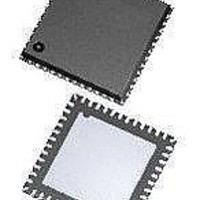MAX16065ETM+ Maxim Integrated Products, MAX16065ETM+ Datasheet - Page 28

MAX16065ETM+
Manufacturer Part Number
MAX16065ETM+
Description
IC SYSTEM MANAGER 12CH 48-TQFN
Manufacturer
Maxim Integrated Products
Datasheet
1.MAX16065ETM.pdf
(62 pages)
Specifications of MAX16065ETM+
Applications
Power Supply Monitor, Sequencer
Voltage - Supply
2.8 V ~ 14 V
Current - Supply
4.5mA
Operating Temperature
-40°C ~ 85°C
Mounting Type
Surface Mount
Package / Case
48-TQFN Exposed Pad
Number Of Voltages Monitored
12
Undervoltage Threshold
2.7 V
Manual Reset
Resettable
Watchdog
Yes
Battery Backup Switching
No
Power-up Reset Delay (typ)
200 us
Supply Voltage (max)
14 V
Supply Voltage (min)
2.8 V
Supply Current (typ)
10 mA
Maximum Power Dissipation
2222 mW
Mounting Style
SMD/SMT
Maximum Operating Temperature
+ 85 C
Chip Enable Signals
No
Internal Hysteresis
Yes
Minimum Operating Temperature
- 40 C
Power Fail Detection
No
Lead Free Status / RoHS Status
Lead free / RoHS Compliant
Voltage - Input
-
Lead Free Status / Rohs Status
Lead free / RoHS Compliant
12-Channel/8-Channel, Flash-Configurable System
Managers with Nonvolatile Fault Registers
Table
During normal operation, a fault condition can be con-
figured to shut down all the EN_OUT_s and store fault
information in the flash memory by setting the appropri-
ate critical fault enable bits. During power-up and pow-
er-down, all sequenced MON_ inputs are considered
critical. Faults during power-up and power-down always
cause the EN_OUT_s to turn off and can store fault infor-
mation in the flash memory, depending on the contents
of r6Dh[1:0]. Set the appropriate critical fault enable bits
in registers r6Eh to r72h (see Table 18) for a fault condi-
tion to trigger a critical fault.
Logged fault information is stored in flash registers r200h
to r20Fh (see Table 19). After fault information is logged,
the flash is locked and must be unlocked to enable a
new fault log to be stored. Write a ‘0’ to r8Ch[1] to unlock
the FAULT flash. Fault information can be configured to
store ADC conversion results and/or fault flags in regis-
ters. Select the critical fault configuration in r6Dh[1:0].
Table
28
_____________________________________________________________________________________
REGISTER
REGISTER
ADDRESS
ADDRESS
16. Deglitch Configuration
17. Fault Flags
1Bh
73h
74h
ADDRESS
BIT RANGE
FLASH
273h
274h
[0]
[1]
[2]
[3]
[4]
[5]
[6]
[7]
BIT RANGE
Critical Faults
MON1
MON2
MON3
MON4
MON5
MON6
MON7
MON8
[6:5]
[6:5]
Overcurrent Comparator Deglitch Time:
00 = No deglitch
01 = 4ms
10 = 15ms
11 = 60ms
Voltage Comparator Deglitch Configuration:
00 = 2 cycles
01 = 4 cycles
10 = 8 cycles
11 = 16 cycles
Set r6Dh[1:0] to ‘11’ to turn off the fault logger. All stored
ADC results are 8 bits wide.
All EN_OUT_s deassert when an overvoltage or under-
voltage fault is detected during power-up/power-down
and the MAX16065/MAX16066 return to the power-
off condition. Fault information can be stored to flash
depending on r6Dh[1:0], see Table 18. GPIO3 and
GPIO8 can be configured as power-up fault outputs
(FAULTPU).
The MAX16065/MAX16066 can be configured for one
of two fault management methods: autoretry or latch-
on fault. Set r74h[4:3] to ‘00’ to select the latch-on-fault
mode. In this configuration, EN_OUT_s deassert after
a critical fault event. The device does not reinitiate the
power-up sequence until EN is toggled or the Software
Enable bit is toggled. See the Enable and Enable2 sec-
tion for more information on setting the software enable
bit.
DESCRIPTION
DESCRIPTION
Power-Up/Power-Down Faults
Autoretry/Latch Mode












